
School BUSRide spoke with Dr. Mervin Daugherty, superintendent of Chesterfield County Public Schools (CCPS) in Virginia, about how his district overcame a major driver shortage. CCPS district was able to achieve 100 percent staffing, hiring 263 drivers in 13 months, and continues to move forward in addressing the shortage crisis.
Dr. Daugherty will participate in an NAPT® webinar on Wednesday, January 25, at 1:00 pm EST, where he will speak to NAPT Executive Director and CEO, Molly McGee-Hewitt, PhD, CAE, about these topics, as well as new strategies to strengthen recruiting and retention rates – and highlighting the value of pupil transportation’s student-focused culture.

Please introduce yourself and tell us about Chesterfield County Public Schools.
I am the superintendent of Chesterfield County Public Schools, located in Central Virginia between Richmond and Petersburg. We are the fifth largest school division in Virginia at 64,000-plus students. We cover roughly 430 square miles, travel about 26,000 miles a day, and bus about 86% of our students.
How have you been affected by the nationwide
driver shortage?
Being a school bus driver is a very challenging job, one of the hardest jobs, not only in education, but in general. The responsibility of driving and maintaining order of 50 to 60 students in a big yellow school bus is extremely difficult. We had a driver shortage before the pandemic, but the pandemic really escalated the problem as people began examining their personal and professional choices and needs on a deeper level. We ask a lot of drivers, including a CDL requirement, which school bus drivers could use to make more money driving a tractor trailer.
Competition in the market, and the challenge of the job are real life components of our current vacancy and will certainly remain issues as we move into the future.
How did you address the shortage?
Our drivers get a new contract August 1st, so there is a two-week dead period for us before the semester starts. It was during that two-week period that we would notice large vacancies. At one point, we were short over 150 drivers right before the school year began. In trying to make sense of it all, we spoke directly with our drivers who pinpointed the two-week dead period as the problem. We immediately went to our local, county government and asked them to partner with us to try to solve this problem.
The amazing piece of this was that we contacted our government officials on a Friday and by that Monday, we had the solution and a plan in place to fund the time gap in our contract. It is important to note that in Virginia, we receive over 50 percent of our funding from the county government. This was not going to be a state solution, but a partnership with our county government.
We would increase the starting pay from $17.20 per hour to $20.20 per hour. We would offer a staffing bonus of $3,000, which would be paid in six stipends throughout the school year. We increased the hours of the drivers. Many of our drivers were on six hours, and we went to seven and eight-hour contracts. These changes caught everybody’s attention immediately. We were very thankful that our county government saw the need as well and helped us fund this opportunity. We are the largest employer in Central Virginia and the largest transportation component in Central Virginia, so this resolution turned out to be a positive, not only the school system, but for the county and for our students and parents.
The other piece that we had to change was our hiring practice. We got out of the school model and went to the business model. We went to Indeed and other online hiring platforms to hire drivers. We already had a monthly hiring fair for drivers, but we turned it into a one-stop shop where interested candidates can complete an application, complete an interview, go through the necessary security protocols, get fingerprinted, be completely onboarded, and set up their physical that is required for bus drivers. Potential candidates became team members because we made the process easy for them: Everything could be done before they left the job fair.
We quickly realized that by the time people left the job fair, got their physical, and started training, the process could take up to several weeks which created another dead period for them and for us. So, we streamlined the process and said, ‘Once you pass your physical, we will put you on the payroll as you go through your training. You will not be able to drive a bus until you obtain your CDL license, but you can be on a bus as a bus monitor or helping in the transportation office. And you are learning the system, so by the time you are getting ready to drive a bus, you have some training under your belt.’ We found that to be a very big help in getting us to the finish line through the training process to hiring drivers.
What was involved with rolling out this plan? How did the community get involved?
Our community was unbelievably supportive. We started the year by asking parents to drive their children to school because we did not have drivers. We were like every other business in America: There was an employee shortage. So this worked out for us, and our parents really did step up.
Once we made our announcement, we also provided everyone with our detailed plan to get drivers. As we started filling the bus routes, we were able to contact parents and let them know that if they would like to put their children back on the bus they could now do so. They responded very well to that. They responded, and throughout the school year we began to see our ridership increase.
How have you reduced entry barriers to becoming a bus driver for your district?
We invite people in. This simple action showed us a 180-degree improvement, just a complete turnaround. We made it a one-stop shopping opportunity, so everybody involved in transportation and HR is at the job fair. Now we have the opportunity to walk you through every step of the process, to schedule your physical, to schedule you for your training, to make sure that when you come into the training that you are ready. We help you. We provide mentors for you going through this opportunity. We try to get you to be part of the family even before you start to drive the bus.
In what measurable ways has your driver shortage been addressed or rectified?
In March we got to 100 percent fill rate. And you always hate to say that because anyone who has a transportation department knows this is an unbelievably fluid and movable component. Because of that we realized that we must have a job fair every month to keep people in the pipeline to enter the hiring process of security and fingerprinting to the interviewing, to physicals, to training, to ride-alongs, to testing. We have to have people in every category of the hiring timetable in order to keep putting new drivers on the road.
We are now very comfortable with the process but it is important to note that we have learned a great deal along the way. We will tweak it again this coming summer as we look at our contracts, stipends, and how the market continues to change. Everybody seems to be at ease with the new system, therefore, as a result of its success we have incorporated this specific, streamlined process to every one of our departmental hiring processes.
What has this approach taught you about recruiting and retention in your district? What lessons would you try to impart to other districts?
First and foremost, talk with your drivers, listen to their suggestions. That is always important. Make sure that you are a true competitor in the market that you are recruiting in, streamline the application and training processes often, and focus on the professional development opportunities that present themselves during school breaks. For example, we used our summer school program (where we transport 10,000 students) as a prime training opportunity to prepare drivers for the start of the school year. These opportunities show your drivers that you are invested in their success. Finally, create the pipeline. That is extremely important. We learned early that we could get people in the pipeline, but they may not stay. We had to look at hiring them as soon as we could, but we know that takes time so making them part of your system by providing training and resources proved to be very beneficial. Once they were part of our team, our chances of retention in the recruitment cycle increased tremendously.
This process has taught us that if we wanted to build a team of drivers who are ready and willing to deliver students to and from school than we needed to create an environment centered around communication and support of those drivers. We are continuously looking to improve upon what we have created but are also very proud of the work that we have done this far to combat our staffing challenges.


